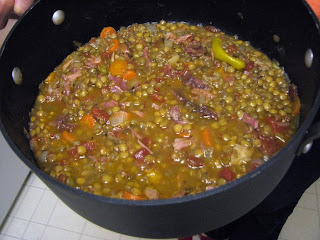
One of my favorite tastes associated with summer is that of the distinctive flavor of the grill. Fortunately, many people seem to agree with me, and so I have already attended several cookouts. However, it is difficult for me to replicate this small pleasure while at home, since I live in a small apartment in the city. My kitchen has no windows, and consequently, very poor ventilation.
I try to make the best of my minuscule kitchen, and I admit that I am rather proud of my ability to cook a wide variety of things within its tight confines. However, one thing that I can't do inside of it is grill, even on an indoor grill pan. The amount of smoke that such pans produce would be too great for my little home, and it's even possible that an attempt to use one would set off the building's fire alarms, and bring fire truck, and I have to assume that such a calamity would be unspeakably embarrassing.
However, just because I can't grill doesn't mean that I can't make one of my favorite grill foods: hamburgers. I preheat my oven to 350 degrees, and place my burgers on top of a rack placed over a cookie sheet. The burgers take twenty to thirty minutes to cook. While they might not have that charcoal taste and classic grill marks, you also don't have to coax a grill to light, fight against winds, or anything else. And I like to add a bit more flavor to my burger mix to make up for the smokiness.

Onion Fontina Burgers
I used fontina cheese, but any flavorful cheese that is slow to melt (usually harder cheeses) would work nicely (perhaps some asiago).
Makes four 1/4 lb burgers
Ingredients
1 cup fontina cheese
1 lb. ground beef
salt and pepper, to taste
1 egg
1 cup bread crumbs
1 small onion (yellow or white)
Preheat the oven to 350 degrees Fahrenheit.
Begin by grating the cheese directly into a medium/large mixing bowl. Place the ground beef on top, and season with salt and pepper.
Add the egg and bread crumbs, then peel and grate the onion on top of everything.
Allow the mixture to sit for a minute or two, then mix together thoroughly, using hands or a spoon (I like to use my hands so I can really mix everything). Allow to rest for a few more minutes, then shape into burgers. Indent the middle of the burgers a bit in order to prevent them from fattening up and cooking unevenly. Place the burgers on top of a rack, placed on top of a baking sheet. Allow to rest again before placing in the oven.
Set a timer for twenty minutes. Allow to cook, checking one or two times. After then twenty minutes, take the burgers out of the oven, check for doneness, and turn them over. Cook the burgers for another five to ten minutes, depending on how well you like them to be cooked.
After removing the burgers from the oven for the final time, allow them to rest a bit. Keep in mind that the burgers will continue to cook a bit more after they are removed from the oven. Serve alone, or atop crusty bread. Spicy mustard and fresh vegetables are a nice addition.










